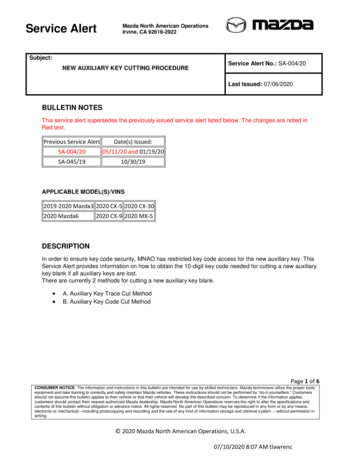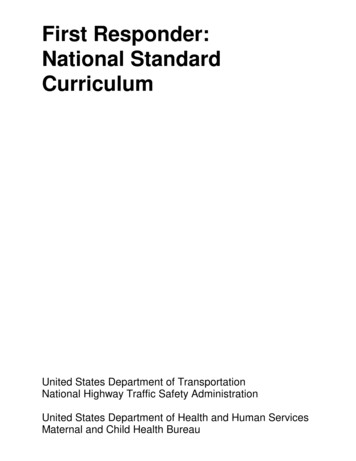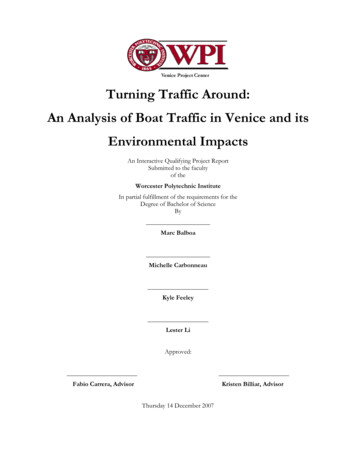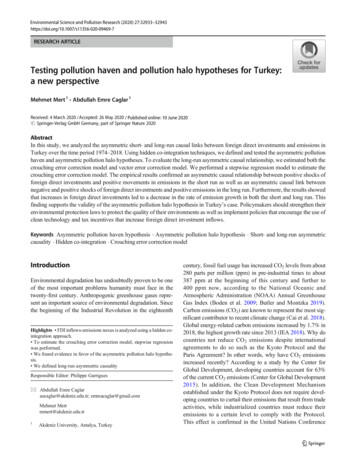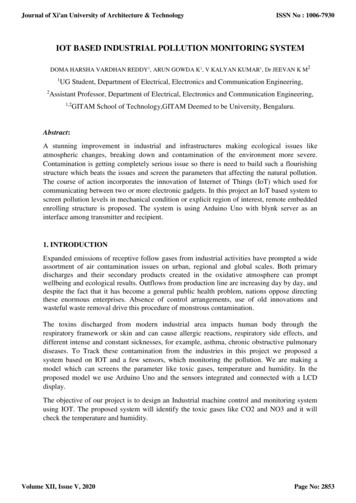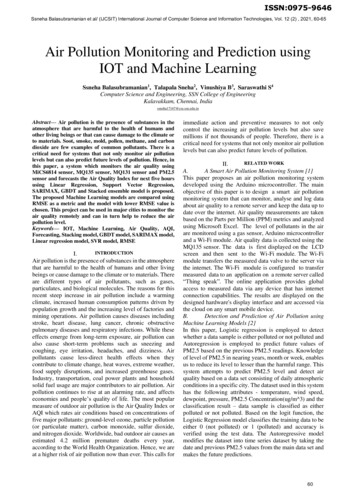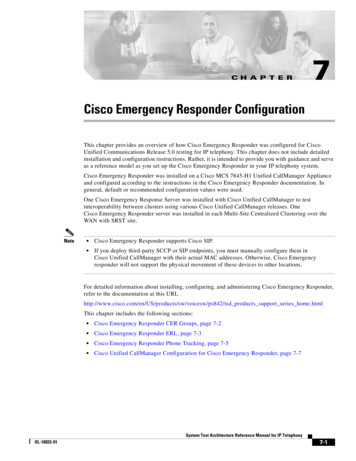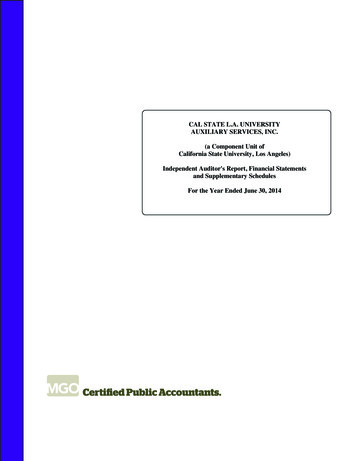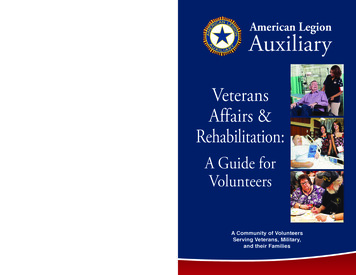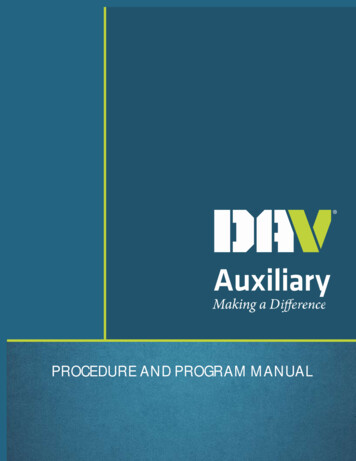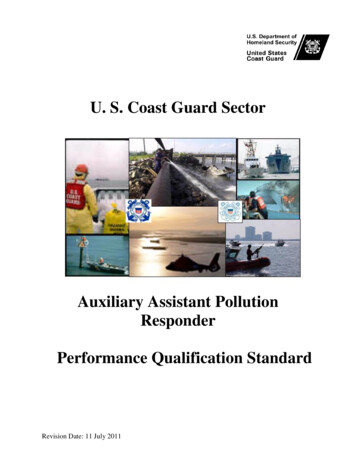
Transcription
U. S. Coast Guard SectorAuxiliary Assistant PollutionResponderPerformance Qualification StandardRevision Date: 11 July 2011
[This page left intentionally blank]
Sector Training GuideAuxiliary Assistant Pollution ResponderPerformance Qualification StandardQualification Code: AUX-EDThis booklet is one section of your personal ‘on the job training’ (OJT) manual. It is your OJTguide to qualification as a Pollution Responder. It is your responsibility to document completedunit training items.Verifying Officers shall be experienced and qualified personnel who have demonstrated theability to evaluate, instruct, and observe other personnel in the performance task criteria.Verifying Officers must be certified in the competencies for which they are to verify and must becommand designated. Verifying Officers must enter their title, name, and initials in the Recordof Verifying Officers section before making entries in your workbook.A Verifying Officer shall observe your successful performance of each task and document suchwith date and initials in the appropriate space provided in this booklet. It may be necessary toperform a task several times. The Verifying Officer will not give credit for any task that is notperformed satisfactory.Auxiliarists do not have law enforcement authority. They cannot independently exercise COTP,OCMI, FMSC or FOSC authority and may become personally liable for actions they take outsideof prescribed directives. Do not allow an Auxiliarist to be placed in a position that willcompromise the limitations on the member’s authority.Certain tasks may require participation in an actual incident response, but the unit’s responseactivity may preclude you from accomplishing these tasks. Therefore, with the approval of theCommand and Verifying Officer, you may utilize exercises and/or training as a means ofaccomplishing the requisite participation in order to fulfill the task requirements.When you have completed all of the items required for this qualification, your command willissue a Letter of Qualification and your Unit Training Coordinator will record and certify theyour qualification in Training Management Tool (TMT). You must forward a copy of yourLetter of Designation to your DIRAUX for entry into AUXDATA.Should any item be waived the qualification is considered local and will not be entered intoAUXDATA and may not be used toward qualification for the Marine Safety (Trident) device.The Program Managers for this PQS is Commandant (CG-533, CG-545 and CG-542) andAuxiliary National Prevention Department.Revision Date: 11 July 2011
[This page left intentionally blank]Revision Date: 11 July 2011
Auxiliary Assistant Pollution ResponderRECORD OF VERIFYING OFFICERSVerifying Officer’s NameTitleInitialsRECORD OF MAJOR TASKS COMPLETEDTaskNumber1.02.03.04.05.0DateMajor TasksCompletedBasics for Pollution Investigation & ResponsePreliminary Assessment & Initiation of ActionInvestigation & Response EffortsComplete Incident Investigation ActivityRecommend Enforcement ActionsRECORD OF COMPLETIONTraining PrerequisitesDateTraining Coordinator’sSignatureA. Completion of resident training course(recommended but not required):1. Pollution Incident Response CourseB. Completion of the following courses:1. ICS 1002. ICS 2003. ICS 3004. ICS 7005. ICS 8006. Hazardous Materials training- Operational level(minimum 8 hours)B. Completion of PQS Workbook.C. Successful completion of unit level oral board.D. Qualification Letter submitted for approval.E. Once Qualification Letter is signed, entercertification in TMT/Direct Access.All qualification requirements have been satisfactory completed by .Revision Date: 8 February 2011
[This page left intentionally blank]
Auxiliary Assistant Pollution ResponderReferencesThe following references will aid you in completing the majority of tasking in this PQS. Area Contingency Plan Comprehensive Environmental Response, Compensation and Liability Act (CERCLA), (42USC §§ 9601-9675) Emergency Response Guidebook Federal Water Pollution Control Act (FWPCA), (33 U SC §§1251-1387) Freedom of Information Act (5 USC §552) Maritime Transportation Security Act (46 USC §701), Oil Pollution Act of 1990 (33 USC §§2701-2761) Privacy Act (5 USC §552A) Refuse Act (33 USC §407), Resource Conservation and Recovery Act (RCRA) (42 USC §§1801-1812) The International Convention for Pollution from Ships, 1973, as modified by the Protocol of1978 (MARPOL 73/78) The International Convention for the Safety of Life at Sea (SOLAS) Title 29 Code of Federal Regulations, Part 1910.120 Title 33 Code of Federal Regulations, in particular:o Subchapter A – Generalo Subchapter H – Maritime Securityo Subchapter L – Waterfront Facilitieso Subchapter M – Marine Pollution Financial Responsibility and Compensationo Subchapter O – Pollutiono Parts 160, 328 and 329 Title 40 Code of Federal Regulations, in particular:o Subchapter I – Environmental Protection Agency Title 46 Code of Federal Regulations, in particular:o Subchapter A – Procedures Applicable to the Public Title 49 Code of Federal Regulations, Part 172 Title 46 United States Codeo Chapter 61 – Reporting Marine Casualties U. S. Coast Guard Civil Penalty Hearing Officer Procedures, COMDTINST 16200.5 (series) U. S. Coast Guard Chemical Hazards Response Information System (CHRIS), COMDTINSTM16465.12 (series) U. S. Coast Guard Civil Penalty Procedures and Administration, COMDTINST 16200.3(series) U. S. Coast Guard Hearing Office’s Case File Assembly Guidelines U. S. Coast Guard Confined Space Entry, COMDTINST 5100.48A (series) U. S. Coast Guard Criminal Enforcement of Environmental Laws, COMDTINST M16201.1(series) U. S. Coast Guard Critical Incident Communications, COMDTINST 3100.8A (series) U. S. Coast Guard Freedom of Information and Privacy Acts Manual, COMDTINSTM5260.3 (series) U. S. Coast Guard Guidance and Procedures for Administering and Enforcing the Oily WasteReception Facility Program, COMDTINST M16450.27 (series) U. S. Coast Guard Incident Command System, COMDTINST 3120.14 (series)
Auxiliary Assistant Pollution Responder U. S. Coast Guard Incident Management Handbook, COMDTPUB P3120.17A (series)U. S. Coast Guard Information and Life Cycles Management Manual, COMDTINSTM5212.12 (series)U. S. Coast Guard Legal Authorities, COMDTPUB 5850.2 (series)U. S. Coast Guard Marine Casualty / Pollution Incident Investigations Job AidMISLE Incident Investigation and Enforcement Process Guide:http://mislenet.osc.uscg.mil/misle user guides.aspxMISLE Incident Investigation and Enforcement User Manual:http://mislenet.osc.uscg.mil/misle user guides.aspxU. S. Coast Guard Marine Safety Laboratory Sample Handling and Transmittal 221/Default.aspxU. S. Coast Guard Marine Safety Manuals, COMDTINST M16000 (series)o Volume V – Investigations and Enforcemento Volume IX – Marine Environmental Protectiono Volume X – Interagency Agreements and AcronymsU. S. Coast Guard Navigation and Inspection Circulars (NVIC)U. S. Coast Guard Notice of Violation User’s Guide, COMDTINST 5582.1 (series)U. S. Coast Guard Sector PQS: Maritime Enforcement Officero Letters of Warningo Notice of Violationso Civil PenaltiesU. S. Coast Guard Office of Investigations and Analysis (CG-545) Policy LettersU. S. Coast Guard Office of Vessel Activities (CG-543) Policy Letter 06-01: Guidance forthe Enforcement of MARPOL Annex I During Port State Control ExaminationsU. S. Coast Guard Public Affairs Manual, COMDTINST 5728.2 (series)o Chapter 113 Official Logbookso Chapter 115 Offenses and Penalties
Auxiliary Assistant Pollution Responder TasksTaskNumberDateCompletedOfficer’s InitialsDemonstrate ability to use applicable United StatesCode, Code of Federal Regulations, Marine SafetyManuals, and Coast Guard Policy Letters.Discuss and demonstrate a working knowledge of alllisted references. To include the following: The National Oil and Hazardous SubstancePollution Contingency Plan Unit Area Contingency Plan(s) and Annexes Vessel and Facility Response Plans andRequirements Outer Continental Shelf Oil Spill ResponsePlans and Requirements if applicableIdentify and explain the differences for the followingterms: Hazardous Waste Hazardous Substance Hazardous Material Oil Release and dischargeDefine “harmful quantity” and “reportable quantity”as found in the FWPCA and CERCLA.1.5Define the term Responsible Party1.6Define the following terms as they apply to FWPCA: Coastal zone Inland zone Coastal waters Inland waters Navigable Waterway Exclusive Economic Zone Territorial Sea Contiguous Zone1.01.11.21.31.4EDTaskVerifyingBasics for Pollution Investigation &Response3Revision Date: 11 July 2011
Auxiliary Assistant Pollution Responder TasksTaskNumberEDTaskDateCompletedOfficer’s Initials1.7Discuss and explain the purpose or use of thefollowing official documents found aboard U.S. andforeign commercial vessels: Certificate of Inspection (COI) Certificate of Documentation (COD) Declaration of Inspection (DOI) International Oil Pollution PreventionCertificate (IOPP) Shipboard Oil Pollution Prevention EmergencyPlan (SOPEP) Oil Record Book (ORB) Certificate of Financial Responsibility (COFR) Official Log Book Cargo Record Book Shipboard Marine Pollution Emergency Plan(SMPEP) Oil Transfer ProceduresExplain the Freedom of Information Act (FOIA): The procedure a public citizen must follow toobtain information under FOIA What information cannot be released underFOIA Who can deny the release of information underFOIA Who has the authority to release informationon an incident investigationExplain the purpose of the Privacy Act: What information is protected Who is subject to the Privacy ActDefine the following spill categories for inland andcoastal spills and identify any reporting requirementsassociated with them: Minor Medium Major1.81.91.104Revision Date: 11 July 2011Verifying
Auxiliary Assistant Pollution Responder VerifyingOfficer’s InitialsDefine the following terms, citing examples, anddescribe the related jurisdictional issues: Marine Casualty Reportable Marine Casualty Significant Harm to the EnvironmentDescribe the following forms anddemonstrate/describe their proper use: Notice of Federal Interest National Response Center Incident Report Report of Marine Casualty (CG-2692) Barge Addendum (CG-2692A) Alcohol Testing Following a Serious MarineIncident (CG-2692B)Describe the safe work practices and other measuresneeded to provide an acceptable level of safety duringpollution investigation and response activities.Discuss the various levels of investigations and whenthey are required. (MSM Vol V Chapter B8) Data Entry Exception Data Collection Informal Formal2.0Preliminary Assessment & Initiationof Action2.1List possible sources of pollution reports and meansof reporting, including: National Response Center Sector Command Center Telephone Report of a Marine Casualty (CG-2692 )Discuss the information contained in a NRC report2.25Revision Date: 11 July 2011
Auxiliary Assistant Pollution Responder TasksTaskNumberDateCompletedOfficer’s InitialsDescribe how to process a MISLE notification.Describe how to link the NRC report and determineincident type.Describe how to Identify and coordinate externaland internal notifications.2.5Explain the Purpose of the Preliminary Investigation.2.6Assist in conducting a preliminary investigation,including: Determining required level of investigation Determining authority / jurisdiction Determining appropriate actions based onclassification (minor, medium, major) Reviewing Responsible Party history Reviewing vessel and/or facility history Identifying the five pollution elements of aviolation Notifying IO shop (vessels & credentialedmariners)Assist in Developing a response strategy for allclassifications of pollution incidents.Forecast the trajectory of a floating pollutant in yourAOR using current technology.Determine if hazardous substance release meets orexceeds the reportable quantity.2.10Describe the HAZWOPER safety requirements.2.11Determine necessary Personal Protective Equipment(PPE) and investigative equipment.Identify the most common oil and hazardousmaterials transported in your zone and their associatedsafety hazards2.32.42.72.82.92.12EDTask6Revision Date: 11 July 2011Verifying
Auxiliary Assistant Pollution Responder TasksTaskNumberEDTaskDateCompletedOfficer’s Initials2.13Define the following characteristics which may beconsidered prior to and during a spill response: Hazard Class Reactivity Physical State Specific Gravity Vapor Density Paths (or Routes) of Entry Threshold Limit Values (TLV)/RecommendedExposure Limits (REL)/Permissible ExposureLimits (PEL) Short Term Exposure Limits (STEL) Immediately Dangerous to Life and HealthConcentrations (IDLH) Lethal Concentration 50% (LCD50)/LethalDose 50% (LD50) Bioaccumulation Bio-oxygen Demand Lower Explosive Limit (LEL)/UpperExplosive Limit (UEL) and Lower FlammableLimit (LFL)/Upper Flammable Limit (UFL) Flash Point Vapor Pressure Boiling PointIdentify potential sources and the hazards associatedwith the following: Benzene Carbon Dioxide Carbon Monoxide Hydrogen disulfide (H2S) Polycyclic aromatic hydrocarbon (PAH) Enriched or Lack of oxygen2.143.0Investigation & Response Efforts3.1Assist in conducting initial assessment on scene andverify pollution report details.7Revision Date: 11 July 2011Verifying
Auxiliary Assistant Pollution Responder letedOfficer’s InitialsDemonstrate familiarity with the Water PollutionIncident Report Workbook (i.e., Blue Book)Obtain on-scene data, including: Wind conditions Tides and Currents Temperature Cloud Coverage PrecipitationAssist in briefing command and providing arecommended course of action.Describe the situations in which additional assistancewould be required from: Federal On-Scene Coordinator Representative Marine investigations Marine inspections District legal Other agenciesIllustrate and state the advantages and disadvantagesof the following physical containment methods: Physical barriers (non-boom) Diking/berming Trenching Overflow and underflow damsExplain the advantages and disadvantages of thedifferent types of boom.Illustrate and explain the advantages anddisadvantages of the different types of boomingstrategies: Exclusion Diversion Collection Containment8Revision Date: 11 July 2011Verifying
Auxiliary Assistant Pollution Responder TasksTaskNumberDateCompletedOfficer’s InitialsIllustrate and explain the mode of operation of thefollowing common skimmer types: Weir Suction Submersion Vortex/Centrifugal Belt skimmer Rope mop skimmerExplain the effects the following factors will have onskimmer performance: Sea State Water Depth Debris Oil thickness Oil viscosityExplain why CG personnel shall not operate non-CGowned equipment (i.e. vessel’s or facility’s shut-offvalves, hose nozzle, etc.)3.15Explain the contents of a Site Safety Plan.3.16Explain the applicability of a Site Safety Plan duringa spill.3.93.10EDTask3.11Define adsorbent and absorbent and explain thedifference between the two terms.3.12Define and identify the following sorbent types: Organic Inorganic Synthetic3.133.14VerifyingIdentify common dimensions and appropriate uses forthe following forms of sorbents: Boom Pad, roll, and blanket Sock, pillow and sweep Snare/pom-pom Particulate9Revision Date: 11 July 2011
Auxiliary Assistant Pollution Responder TasksTaskNumberEDTaskDateCompletedOfficer’s Initials3.17Assist in conducting a shoreline cleanup assessment.3.18Complete an ICS Form 201 (Incident Briefing Form)3.19Describe the following types of evidence and giveexamples: Documentation Physical Oil SamplesDescribe the handling and processing procedures thatare unique to each of the following: difference between civil and criminal evidence oil samples witness statements photographs and/or video diagrams and charts vessel and/or facility logsList the types of samples necessary to provide theMarine Safety Laboratory with sufficient physicalevidence to perform “fingerprint” identification.Define confined spaces and describe the hazardsassociated with confined spaces. Describe the Coast Guard policy concerningconfined space entry.Describe the occasions and policies for entry ontoprivate property. Secured (locked gate) Unsecured (open gate)Describe Interviewing witnesses and preparation awritten statement based on a verbal interview and howit is attached in MISLE.Describe how to record a Time Line and capture theActions, Conditions, and Events in MISLE.Explain the purpose and use of the following: Captain of the Port Order3.203.213.223.233.243.253.2610Revision Date: 11 July 2011Verifying
Auxiliary Assistant Pollution Responder TasksTaskNumberEDTaskDateCompletedOfficer’s InitialsDescribe how to Create a Notification and anIncident Investigation Activity (IIA) in MISLE.Describe how to Prepare a written statementsummarizing an investigation.4.3Describe how to enter evidence into the IIA.4.4Describe how to locate involved parties/subjects inMISLE and make them referential 4.04.14.2VerifyingAdministrative Order (response document)Complete Incident InvestigationActivity4.5Describe the required File Details for: Known pollution source Mystery spill4.6Describe how to Create an Enforcement Referral andunderstand the differences between: Letter of Warning Notice of Violation Civil PenaltyDescribe how to Complete IIA and submit it to theSenior Investigating Officer (or InvestigationsDivision Chief) via your appropriate supervisor.4.75.0Recommend Enforcement Actions5.1Describe the elements of the following: Civil Penalty violation ‘Failure to notify’ violation Class II civil penalty Criminal violation Refuse Act violation MARPOL violation Notice of Violation (NOV or ticket)11Revision Date: 11 July 2011
Auxiliary Assistant Pollution Responder TasksTaskNumberEDTaskDateCompletedOfficer’s Initials5.2Define each of the following penalty procedures andlist the circumstances in which each might be applied: Letter of Warning Notice of Violation Class I Civil Penalty Class II Civil Penalty Judicial Civil PenaltyDescribe the purpose of a Letter of Undertaking: When would this be issued? What are the requirements for issuing? Issuance authority?Describe the purpose of a Surety Bond: When would this be issued? What are the requirements for issuing? Issuance authority?5.35.412Revision Date: 11 July 2011Verifying
INCIDENT LOGDateIncident DescriptionPosition Filled13Revision Date: 11 July r’sInitials
[This page left intentionally blank]14Revision Date: 11 July 2011
Command’s NameStreet AddressCity, State Zip CodeStaff Symbol:Phone:Email:1601DATEMEMORANDUMFrom:I. M. Frank, CAPTUnit’s NameReply toAttn of:To:M. O. Ore, USCG AuxiliarySubj:QUALIFICATION AS AUXILIARY ASSISTANT POLLUTION RESPONDERRef:Auxiliary Assistant Pollution Responder Performance Qualification Standard Workbook1. Congratulations! You have completed all requirements necessary to perform the duties of aAuxiliary Assistant Pollution Responder. You are authorized to carry out the responsibilities ofan Auxiliary Assistant Pollution Responder within the scope of your qualifications. This is asignificant milestone in your professional development and I commend your accomplishments.2. This Letter of Qualification should be retained as part of your personal Training Record andyou will be assigned the Pollution Responder’s Qualification Code “AUX-ED”.#
U. S. Coast Guard Incident Management Handbook, COMDTPUB P3120.17A (series) U. S. Coast Guard Information and Life Cycles Management Manual, COMDTINST M5212.12 (series) U. S. Coast Guard Legal Authorities, COMDTPUB 5850.2 (series) U. S. Coast Guard Marine Casualty / Pollution Incident Investigations Job Aid

